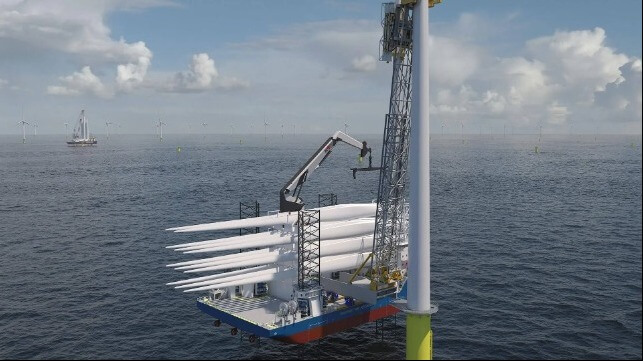Blade Installation Vessel Could Solve Large Wind Turbine Challenges

Rapid growth in the offshore wind sector and the move to larger wind turbines with longer blades is giving rise to the need for more specialized installation vessels. In the latest proposal, designers at GustoMSC working with NOV Lifting & Handling have developed a design for a specialized smaller lifting vessel for blades that they report can make the installation process more efficient.
They point out that the installation process is growing more challenging and resulting in more downtime as wind turbines are getting larger. The newest generations of turbines they point out use higher towers ranging between 575 and 650 feet to accommodate larger blades. At those heights, the towers are becoming more susceptible to high winds which cause motion and delay the installation process.
GustoMSC and NOV began working on their solution in early 2021. They produced a design for a vessel they call Sjøhest (Norwegian for seahorse), a dedicated wind blade installation jack-up vessel. It is specifically designed to handle the challenges of installing blades at these heights and would free up the more costly large installation vessels to focus on towers and nacelles. By separating the installation process, the larger jack-up vessels with the heavy lift cranes, which are in short supply in the industry, and come with higher day rates, would be required for less time during the installation.
The dedicated blade installation jack-up vessel is equipped with a smaller handling crane and trolley with a telescopic leader boom is used specifically to install the blades. Using the telescopic leader boom, Sjøhest connects itself to the tower, creating an aligned movement for safe and efficient blade installation. This would permit the blade vessel to remain aligned with the tower reducing downtime due to weather conditions at the site.
Blades would be loaded on to the racks at dedicated shore marshaling points using a roll-on/roll-off process which would also speed the loading. Once the vessel is alongside the tower and attached, the smaller handling crane picks up the blades from the blade rack and feeds the trolley. Once the blade is connected to the trolley, the trolley horizontally transports the blade along the leader, rotates the blade into a vertical position, and connects it to the rotor. According to the companies, all three blades per turbine can be installed within one day.
In addition, the installation methodology with Sjøhest enables splitting tower/nacelle and blade mobilization into separate onshore hubs. Due to their size, existing and future blades create a huge necessity for space.
Part of the advantages of the blade installation vessel approach the companies highlight is the ability to separate the onshore marshaling operations to have a dedicated port addressing the needs of the blades. They believe it will create more flexibility in the mobilization location and benefits the entire logistics process.
